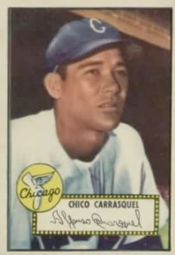
The Latino "Boom"
Influx of Latinos in the Major Leagues post-WWII
As a result of Mexican League players being declared ineligible for Major League Baseball, Latino players in the late 1940s and early 1950s were forced to choose between the two, and many chose the Major Leagues. Also, in 1949, the Cleveland Indians signed Minnie Miñoso, the first black Latino in the MLB, effectively ending segregation and opening the door to the multitude of black Latino baseball players to play at the Major League level (13).
Though Latinos had experienced success before in the MLB, none had been generally regarded as "stars" by the media and the general public. This all began to change in 1951 when both Minnie Miñoso and Alfonso "Chico" Carrasquel were named to the All Star team, making them the first two Latinos to play in an All Star game in MLB history. During the 1950s, Latinos such as Minnie Miñoso, Alfonso Carrasquel, Orlando Cepeda, Roberto Clemente, and Louis Aparicio made it acceptable for the general public to embrace Latino baseball players in Major League Baseball. Three of these, Clemente, Cepeda, and Aparicio, would be among the first Latinos elected into the National Baseball Hall of Fame, while Miñoso, as of 2006, is still on the Hall of Fame ballot, waiting to be voted into the hall.
At the same time baseball was growing almost exponentially in popularity in the United States, Fidel Castro came to power in Cuba and abolished the Cuban League. The flow of Cuban talent into the Majors, always at the forefront of Latin America, was halted. Some players who happened to already be in the United States at this time and some early defectors, most notably Tony Oliva and Tony Pérez, found success in the MLB, but for the most part Cuba was now all but cut off from Major League Baseball.
Though Cuban players could no longer play in the United States, the number of Latino players overall did not slow at all. Players from Puerto Rico were increasing in numbers never before experienced by Major league Baseball during the 1960s, paralleling the expansion of the league, which grew from 16 to 24 teams from 1961 to 1969 (14). By the late 1960s, Latino players were becoming commonplace on MLB rosters and were beginning to exert more and more influence on the game as their presence within the league continued to expand.